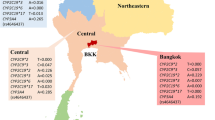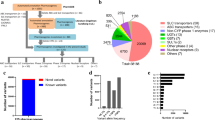Abstract
Several studies have shown that many polymorphisms of the xenobiotic-metabolizing enzymes (XME) affect either enzymatic functions or are associated with various aspects of human health. Owing to the presence of these single nucleotide variants (SNVs), differences in detoxification capacity have been observed between many ethnicities. The aim of this investigation was to study the prevalence of four polymorphisms in XME among various ethnic groups. Attention was focused on polymorphisms of CYP2D6 (rs1058172, G>A, p.Arg365His), CYP1A1 (rs4646421, c.-26-728C>T), NAT1 (rs4921880, c.-85-1014T>A) and NAT2 (rs1208, A>G, p.Arg268Lys). These polymorphisms were analyzed in 261 healthy Tunisians individuals in comparison with different ethnic backgrounds from hapmap database. In addition, in silico functional prediction was also performed to determine the loss of function variants. Our results demonstrated that population’s origins widely affect the genetic variability of XME enzymes and Tunisians show a characteristic pattern. In silico predictions showed a deleterious effect for p.Arg268Lys substitution on CYP2D6 function, findings confirmed its key role played in cancer susceptibility. These data show that detoxification genes structures depend on the studied population. This suggests that ethnic differences impact on disease risk or response to drugs and therefore should be taken into consideration in genetic association studies focusing on XME enzymes. Our results provide the first report on these SNV in Tunisian population and could be useful for further epidemiological investigations including targeted therapy.


Similar content being viewed by others
References
Li M, Peng RS, Wei C, Lu Q (2012) A U-statistic-based random forest approach for genetic association study. Front Biosci 4:2707–2717
Mroziewicz M, Tyndale RF (2010) Pharmacogenetics: a tool for identifying genetic factors in drug dependence and response to treatment. Addict Sci Clin Pract 5:17–29
Boffetta P (2010) Biomarkers in cancer epidemiology: an integrative approach. Carcinogenesis 31:121–126
Nebert DW (2001) Pharmacogenomics, ethnicity, and susceptibility genes. Pharmacogenomics J 1(1):19–22
Gajecka M, Rydzanicz M, Jaskula-Sztul R, Kujawski M, Szyfter W, Szyfter K (2005) CYP1A1, CYP2D6, CYP2E1, NAT2, GSTM1 and GSTT1 polymorphisms or their combinations are associated with the increased risk of the laryngeal squamous cell carcinoma. Mutat Res 574(1–2):112–123
Ioannides C (2001) Enzymes systems that metabolise drugs and other xenobiotics. Wiley, UK, p 567
Roberts-Thomson SJ, McManus ME, Tukey RH, Gonzalez FF, Holder GM (1993) The catalytic activity of four expressed human cytochrome P450s towards benzoapyrene and the isomers of its proximate carcinogen. Biochem Biophys Res Commun 192:1373–1379
Singh AP, Shah PP, Ruwali M, Mathur N, Pant MC, Parmar D (2009) Polymorphism in cytochrome P4501A1 is significantly associated with head and neck cancer risk. Cancer Invest 27:869–876
Olivieri HER, Silva SD, Mendonça FF et al (2009) CYP1A2*1C CYP2E1*5B and GSTM1 polymorphisms are predictors of risk and poor outcome in head and neck squamous cell carcinoma patients. Oral Oncol 45:e73–e79
Tai J, Yang M, Ni X, Yu D et al (2010) Genetic polymorphisms in cytochrome P450 genes are associated with an increased risk of squamous cell carcinoma of the larynx and hypopharynx in a Chinese population. Cancer Genet Cytogenet 196:76–82
Wang D, Su M, Tian D, Liang S, Zhang J (2012) Associations between CYP1A1 and CYP2E1 polymorphisms and susceptibility to esophageal cancer in Chaoshan and Taihang areas of China. Cancer Epidemiol 36:276–282
Zhou X, Wang Y, Hu T, Or PM, Wong J et al (2013) Enzyme kinetic and molecular docking studies for the inhibitions of miltirone on major human cytochrome P450 isozymes. Phytomedicine 20(3–4):367–374
Ahmad ST, Arjumand W, Seth A, Nafees S, Rashid S, Ali N, Hamiza OO, Sultana S (2012) Risk of renal cell carcinoma and polymorphism in phase I xenobiotic metabolizing CYP1A1 and CYP2D6 enzymes. Urol Oncol 31(7):1350–1357
Islam MS, Ahmed MU, Bin Sayeed MS, Al Maruf A, Mostofa AG et al (2013) Lung cancer risk in relation to nicotinic acetylcholine receptor, CYP2A6 and CYP1A1 genotypes in the Bangladeshi population. Clin Chim Acta 416:11–19
Chaudhuri SR, Mukherjee S, Paul RR, Haldar A, Chaudhuri K (2013) CYP1AI and CYP2E1 gene polymorphisms may increase susceptibility to oral submucous fibrosis among betel quid chewers of eastern India. Gene 513:268–271
Li R, Yao-Shugart Y, Zhou W, An Y et al (2009) Common genetic variations of the cytochrome P450 1A1 gene and risk of hepatocellular carcinoma in a Chinese population. Eur J Cancer 45:1239–1247
Khlifi R, Chakroun A, Hamza-Chaffai A, Rebai A (2014) Association of CYP1A1 and CYP2D6 gene polymorphisms with head and neck cancer in Tunisian patients. Mol Biol Rep 41(4):2591–2600
Wang S, Chanock S, Tang D, Li Z, Jedrychowski W, Perera FP (2008) Assessment of interactions between PAH exposure and genetic polymorphisms on PAH–DNA adducts in African American, Dominican and Caucasian mothers and newborns. Cancer Epidemiol Biomarkers Prev 17(2):405–413
Sim SC, Kacevska M, Ingelman-Sundberg M (2013) Pharmacogenomics of drug-metabolizing enzymes: a recent update on clinical implications and endogenous effects. Pharmacogenomics J 13(1):1–11
Cholerton S, Arpanahi A, McCracken N et al (1994) Poor metabolisers of nicotine and CYP2D6 polymorphism. Lancet 343:62
West WL, Knight EM, Pradhan S, Hinds TS (1997) Interpatient variability: genetic predisposition and other genetic factors. J Clin Pharmacol 37:635–648
Sekine A, Saito S, Iida A, Mitsunobu Y, Higuchi S, Harigae S, Nakamura Y (2001) Identification of single-nucleotide polymorphisms (SNPs) of human N-acetyltransferase genes NAT1, NAT2, AANAT, ARD1 and L1CAM in the Japanese population. J Hum Genet 46(6):314–319
Demokan S, Suoglu Y, Gözeler M, Demir D, Dalay N (2010) N-acetyltransferase 1 and 2 gene sequence variants and risk of head and neck cancer. Mol Biol Rep 37(7):3217–3226
Hirvonen A (1999) Polymorphic NATs and cancer predisposition. IARC Sci Publ 251–270
Gara S, Abdennebi M, Chatti S, Touati S, Ladgham A, Guemira F (2007) Association of NAT2 gene substitution mutation T341C with increased risk for head and neck cancer in Tunisia. Acta Oncol 46:834–837
Ambrosone CB, Kropp S, Yang J, Yao S, Shields PG, Chang-Claude J (2008) Cigarette smoking, N-acetyltransferase 2 genotypes, and breast cancer risk: pooled analysis and meta-analysis. Cancer Epidemiol Biomarkers Prev 17:15–26
Rouissi K, Ouerhani S, Marrakchi R, Ben Slama MR et al (2009) Combined effect of smoking and inherited polymorphisms in arylamine N-acetyltransferase 2, glutathione S-transferases M1 and T1 on bladder cancer in a Tunisian population. Cancer Genet Cytogenet 190(2):101–107
de Lima Junior MM, Reis LO, Guilhen AC, Granja F et al (2012) N-acetyltransferase-2 gene polymorphisms and prostate cancer susceptibility in Latin American patients. Med Oncol 29(4):2889–2894
Heck JE, Moore LE, Lee Y-CA, McKay JD et al (2012) Xenobiotic metabolizing gene variants and renal cell cancer: a multicenter study. Cancer Epidemiol Prev 2:16
García-Closas M, Malats N, Silverman D, Dosemeci M et al (2005) NAT2 slow acetylation, GSTM1 null genotype, and risk of bladder cancer: results from the Spanish Bladder Cancer Study and meta-analyses. Lancet 366(9486):649–659
Hou YY, Ou HL, Chu ST, Wu PC et al (2011) NAT2 slow acetylation haplotypes are associated with the increased risk of betel quid- related oral and pharyngeal squamous cell carcinoma. Oral Surg Oral Med Oral Pathol Oral Radiol Endod 112(4):484–492
Majumder M, Ghosh S, Roy B (2012) Association between polymorphisms at N-acetyltransferase 1 (NAT1) & risk of oral leukoplakia and cancer. Indian J Med Res 136(4):605–613
Mikuls TR, Levan T, Gould KA, Yu F et al (2012) Impact of interactions of cigarette smoking with NAT2 polymorphisms on rheumatoid arthritis risk in African Americans. Arthritis Rheum 64(3):564–655
Gibson TM, Smedby KE, Skibola CF, Hein DW et al (2013) Smoking, variation in N-acetyltransferase 1 (NAT1) and 2 (NAT2), and risk of non-Hodgkin lymphoma: a pooled analysis within the InterLymph consortium. Cancer Causes Control 24(1):125–134
Agundez JA, Olivera M, Martinez C, Ladero JM, Benitez J (1996) Identification and prevalence study of 17 allelic variants of the human NAT2 gene in a white population. Pharmacogenetics 6:423–428
Garte S, Gaspari L, Alexandrie AK et al (2001) Metabolic gene polymorphism frequencies in control populations. Cancer Epidemiol Biomarkers Prev 10:1239–1248
Ben Salah G, Kallabi F, Maatoug S, Mkaouar-Rebai E et al (2012) Polymorphisms of glutathione S-transferases M1, T1, P1 and A1 genes in the Tunisian population: an intra and interethnic comparative approach. Gene 498:317–322
Ben Salah G, Fendri-Kriaa N, Kamoun H (2012) An interethnic variability and a functional prediction of DNA repair gene polymorphisms: the example of XRCC3 (p.Thr241>Met) and XPD (p.Lys751>Gln) in a healthy Tunisian population. Mol Biol Rep 39(10):9639–9647
Ben Salah G, Ayadi I, Fendri-Kriaa N et al (2012) DNA repair gene polymorphisms at XRCC1 (Arg194Trp, Arg280His, and Arg399Gln) in a healthy Tunisian population: interethnic variation and functional prediction. Genet Test Mol Biomarkers 16(10):1218–1225
Lewin HA, Stewart-Haynes JA (1992) A simple method for DNA extraction from leukocytes for use in PCR. Biotechniques 4:522–524
Ng PC, Henikoff S (2001) Predicting deleterious amino acid substitutions. Genome Res 11:863–874
Ng PC, Henikoff S (2002) Accounting for human polymorphisms predicted to affect protein function. Genome Res 12:436–446
Beroud C, Collod-Beroud G, Boileau C, Soussi T, Junien C (2000) Universal mutation database, a generic software to build and analyze locus-specific databases. Hum Mutat 15:86–94
Beroud C, Hamroun D, Collod-Beroud G et al (2005) Universal mutation database, update. Hum Mutat 26:184–191
Ben Arab S, Masmoudi S, Beltaief N et al (2004) Consanguinity and endogamy in Northern Tunisia and its impact on nonsyndromic deafness. Genet Epidemiol 27:74–79
Kerkeni E, Monastiri K, Saket B et al (2007) Interplay of socioeconomic factors, consanguinity, fertility, and offspring mortality in Monastir, Tunisia. Croat Med J 48:701–707
Acknowledgments
This work was supported by the Ministry of Higher Education and Scientific Research, Tunisia. We thank the Habib Borguiba Hospital, Sfax, Tunisia for the recruitment of participants. We thank also Dr. Adel Chakroun and Dr. Bouthaina Hammami for their efforts and assistance in recruiting patients.
Conflict of interest
The authors declare that they have no conflict of interest.
Author information
Authors and Affiliations
Corresponding author
Electronic supplementary material
Below is the link to the electronic supplementary material.
Rights and permissions
About this article
Cite this article
Khlifi, R., Ben Salah, G., Chakroun, A. et al. Inter-ethnic differences in genetic polymorphisms of xenobiotic-metabolizing enzymes (CYP1A1, CYP2D6, NAT1 and NAT2) in healthy populations: correlation with the functional in silico prediction. Mol Biol Rep 41, 5735–5743 (2014). https://doi.org/10.1007/s11033-014-3445-6
Received:
Accepted:
Published:
Issue Date:
DOI: https://doi.org/10.1007/s11033-014-3445-6




